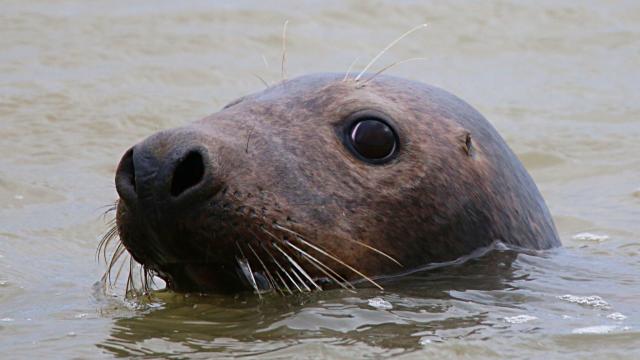You’re familiar with the food chain: Little fish eats plankton, bigger fish eats the little fish, then a seal eats the bigger fish, thus consuming the energy from all three smaller animals. But what if the little fish had also eaten an indigestible piece of plastic? New evidence demonstrates the plastic could make it all the way up the food chain into the seal.
Image: nick goodrum/Flickr
This process is called trophic transfer. Scientists have called for increased research on whether these ever-present plastic fragments travel up the food chain in this way. So a team of British researchers has, for the first time, demonstrated direct experimental evidence of microplastics transferring to a top marine predator via trophic transfer.
“Our findings suggest that trophic transfer represents an indirect, yet potentially major, pathway of microplastic ingestion for any species whose feeding ecology involves the consumption of whole prey,” the authors write in the study, published recently in the journal Environmental Pollution.
There’s a lot of fear surrounding microplastics. After all, these bits end up all over the ocean, might have potential health impacts to fish, and have even led to some controversy and a possibly faked study. But fish are eating microplastics, and it’s there’s a good chance it isn’t good for the marine ecosystem. Scientists don’t yet know how far up the food chain it’s going, and whether it’s bad for us humans (who already eat a lot of indigestible garbage anyway).
Others have demonstrated some level of microplastic trophic transfer in lower-level organisms. But the difficulty of setting up controlled experiments in nature have made analysing this effect difficult in top predators, the authors write. Here, the researchers were able to study 31 captive seals from the United Kingdom’s Cornish seal sanctuary. They fed the seals wild-caught Atlantic mackerel and analysed both the fish bellies and seal poop for plastic.
And plastic there was – a third of the fish and half of the seal poop had a handful of plastic pieces around a millimetre or two in length.
“The study convincingly showed that plastic in mackerel fed to seals could be detected in seal scat,” Sjúrður Hammer, a researcher not involved in the study who studies plastics in seabirds at the University of Glasgow in Scotland, told Gizmodo.
This is convincing research, but has its limitations, said Claudia Halsband from Norwegian aquaculture research and consultancy company Akvaplan-niva, who was not involved with the study. It was clear that the fibres in the fish were not the exact same ones in the seals. “This is not surprising, and the authors point that out, as the fish examined were not the same fish that were offered to the seals as food,” she told Gizmodo. “Hence all interpretations based on findings for these two groups of animals that have not been in direct contact with each other (i.e. no direct trophic link through feeding) have to be very general and need to be treated with caution.”
Others also told me to be careful about the study’s results more generally: “It’s important to be very clear about the conclusion of this study,” said Hammer. “They have shown evidence of trophic transfer, but this is not necessarily evidence that microplastic is ‘bioaccumulating up the food chain’,” like mercury does in tuna. He pointed out that there’s media hype around marine plastic – but it’s not as concerning to him as other long-lived environmental pollutants, such as DDT and dioxins, which have more evidence linking them to harm and are known as “persistent organic pollutants“. The authors did not respond to requests for comment.
All of the researchers Gizmodo contacted still felt the paper’s findings were important, and that it was logical that microplastics in fish will get into seals. Paula Sobral from the Universidade Nova de Lisboa noted that studying trophic transfer to these top predators is an especially difficult task.
There’s a lot of work still needed before we understand microplastics’ potential harm to animals, how long those plastic bits stay in digestive tracts, and how they accumulate. There isn’t much convincing evidence of harms to humans yet. In any case, there are more pressing threats to the ocean – oil spills, for example.
Hammer summed it up: “There are great unknowns in the research of marine plastic, but this paper is a big step forward for plastic in marine mammal research.”
